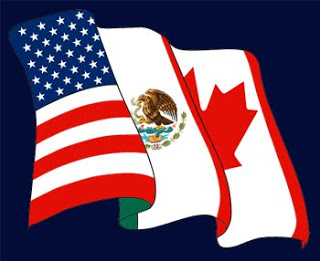Dana Gabriel
Be Your Own Leader
It was surprising that bilateral relations with the U.S. did not play a more prominent role during the recent Canadian election considering that both countries are pursuing a trade and security agreement. In fact, the issue did not really surface until the dying days of the campaign. After winning a much coveted majority government, Stephen Harper’s Conservatives are moving ahead quickly with perimeter security and regulatory harmonization negotiations. NAFTA and the defunct Security and Prosperity Partnership (SPP) both addressed issues such as regulatory cooperation. The push for a single unified North American business-friendly regulatory regime continues on different fronts.
In the final week of the Canadian election campaign, consumer advocate and four-time candidate for President of the United States, Ralph Nader warned about Canada-U.S. deep integration. In an open letter to Prime Minister Stephen Harper, he raised concerns over the lack of transparency regarding talks between the two countries on a trade and border security deal. Nader cautioned that a, “North American Security Perimeter Agreement will wrap many Canadian concerns — your Arctic, water, energy, anti-monopoly and foreign investment reviews — in a bi-national security blanket.” He added, “The corporatist lobbies and what President Eisenhower warned Americans about in his farewell address 50 years ago — ‘the military-industrial complex’ — will favour this lucrative and anti-democratic initiative.” Nader also explained in his letter to Harper, that, “Canada’s prudent bank regulation prevented a Wall Street style collapse of your economy.” North American deep integration is a corporate-led agenda designed to foster privatization and deregulation.
With just days left before the election on May 2, Prime Minister Stephen Harper announced that a re-elected Conservative government would move forward on the Shared Vision for Perimeter Security and Economic Competitiveness signed with U.S. President Barack Obama back in February of this year. The deal would help promote trade while strengthening security and regulatory cooperation between both countries. Harper vowed that the agreement is critical for Canadian jobs and economic growth. He reaffirmed plans to cut regulatory barriers to cross-border trade through the United States-Canada Regulatory Cooperation Council (RCC) which is a component of the Beyond the Border declaration. Following Harper’s election victory, President Obama phoned to congratulate him and at the same time renewed his commitment to the proposed perimeter security deal, as well as the RCC. Both leaders appear eager to complete an agreement before the 2012 U.S. election cycle gets fully underway.
On February 4, 2011, President Obama and Prime Minister Harper addressed ways to coordinate and harmonize regulations in order to ease red tape for businesses that do trade on both sides of the border. They announced the creation of the U.S.-Canada RCC which will, “promote economic growth, job creation, and benefits to our consumers and businesses through increased regulatory transparency and coordination.” According to a joint statement, the leaders, “are committed to working through the RCC to provide early notice of regulations with potential effects across our shared border, to strengthen the analytic basis of regulations, and to help make regulations more compatible.” Both countries will also, “work through the RCC to determine sectors on which to focus its work that are characterized by high levels of integration, significant growth potential, and rapidly evolving technologies.” There are fears that the RCC could erode any independent Canadian regulatory capacity and weaken existing regulations. This would lead to a race to the bottom with respect to regulatory standards
In May of 2010, U.S. President Barack Obama and Mexican President Felipe Calderon directed the creation of the High-Level Regulatory Cooperation Council (HLRCC). In March of this year, the leaders laid out specific goals for the HLRCC. This included linking regulatory cooperation to improve border-crossing and customs procedures, increasing regulatory transparency, as well as making regulations more compatible and simple. The U.S. and Mexico will also focus on increasing technical cooperation and improving the analysis of regulations. The HLRCC has similar goals to the U.S.-Canada RCC. At some point, these dual-bilateral initiatives could come together to form a single continental regulatory model.


Be the first to comment on "The Push for a Single Unified North American Regulatory Regime"